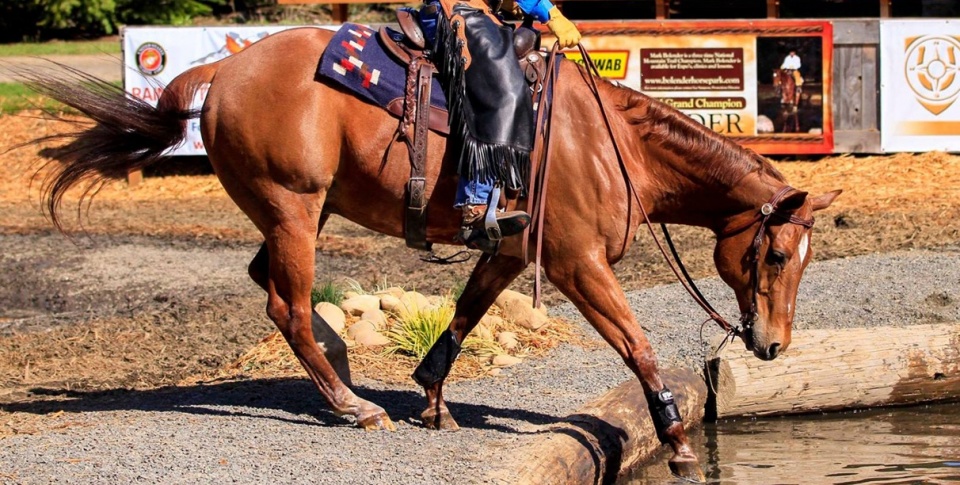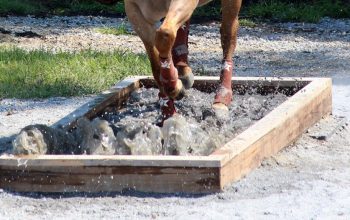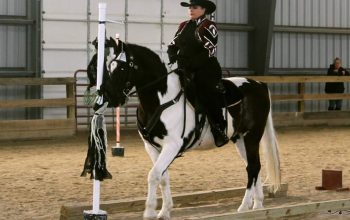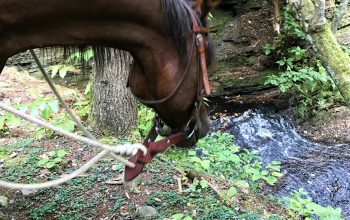BACK TO BASICS
By Mark Bolender
The discipline of Mountain Trail has its hazards and potential for injury in many areas. I feel we as trainers and riders have an obligation to protect our horses to the best of our ability. Over the years I have noticed that some riders have horses who go along for years without any serious injuries while other riders seem to have horses that are constantly hurt or always are sustaining injuries or have some sort of health-related issue. As the years have flown by the facts begin to add up and I realized that there is a common thread for both groups of horse owners and why one group of horsemen seem to have a higher rate of problems. First these are all general facts for all of us who have horse understand that a horse can injure itself out of the blue without any reason that we can find but I am talking about is lowering the odds that your horse will sustain injuries from the discipline of Mountain Trail.

The horse owners with the lowest odds of sustaining injury to the horse are the ones that have “broke” horses. This sounds too simple but a broke horse and a good rider have more tools to deal with an adverse situation or skills to navigate a new obstacle. The question now is how riders get the skills to lower the risk of injury.
1. First go back to the basics of walking, trotting and cantalouping (canter or lope) a straight line. Set up at eight sets of cones for at least eighty feet. Yes, this sounds to simple but we find only one out of ten can ride a straight line at the clinics. Everyone laughs when I bring out the cones anywhere in the world but it is always the same. The way to ride a straight line is to focus forward and use your legs and seat. Most try to ride the face and it will always be a crooked line.
2. The next exercise is to ride a twenty-meter circle through cones that are set 36” apart. Again, the way to be successful is to look ahead and not down at the set of cones you are riding through. You always look ahead one set of cones and then you can run a nice circle.

3. Work on your transitions to the point where you can go from a trot to a walk at any given point that it is asked for. If you ask for a walk but it takes 20 feet to get it you are not ready to move up to the cantaloupe. In level II of Mountain Trail where you are now trotting between obstacles you must be able to transition at the obstacle and if you can’t you are setting yourself and your horse up for injury. In level III you must be able to transition down to a walk from a cantaloupe at the obstacle. This means that you need to have the skill to transition down in an arena before you
attempt this on the Mountain Trail course. Transitions are one skill that the safe riders have.
4. Make sure you have a soft correct backup. It is surprising how many do not have this skill and when they need it the horse and rider become frustrated and often put both horse and rider in danger. If you do not have this skill find a professional to help you for it is critical.
5. Be able to move the haunches and shoulders at will which will also give you a nice leg yield.
6. Protect your horse with leg wraps.
7. Wisdom to avoid what appear to be unsafe or poorly constructed obstacles. With the growth of trail obstacle training and completions there are many obstacles which we have seen around the globe that are very unsafe. With the information age where we can see all kinds of obstacles on the internet many try to copy designs without understanding the engineering that is hidden within the obstacle. As the refinement of the sport has grown along with the obstacles the structural capabilities have all been increase with safely always first in mind. The dream of a ribbon is not worth taking the risk of navigating an obstacle that may fail and cause injury.
8. Make sure your horse can stand still!!!! Teach this and you will end up with a quite horse which is a joy to be around. It is easy to teach but often not done because with have no time to just sit and enjoy the horse.
 I am sure there are many other skills that a good horse person has but these are a few skills that I see possessed by the rides that have the most fun and have the less injuries and healthier horses than the average rider.
I am sure there are many other skills that a good horse person has but these are a few skills that I see possessed by the rides that have the most fun and have the less injuries and healthier horses than the average rider.
Happy Trails and Bolender Blessings.
Mark Bolender
Learn more about IMTCA online >
Building Confident Horses, one obstacle at a time




